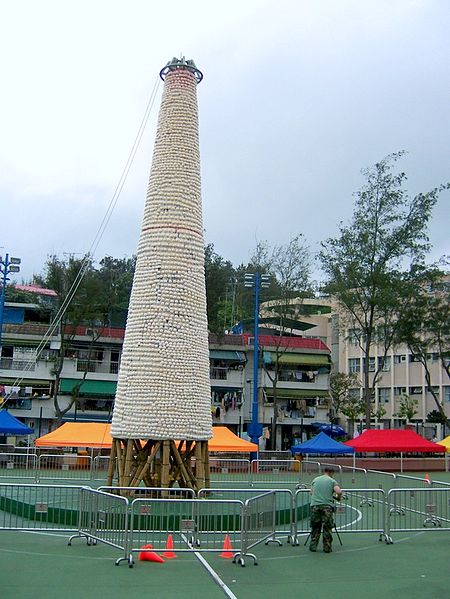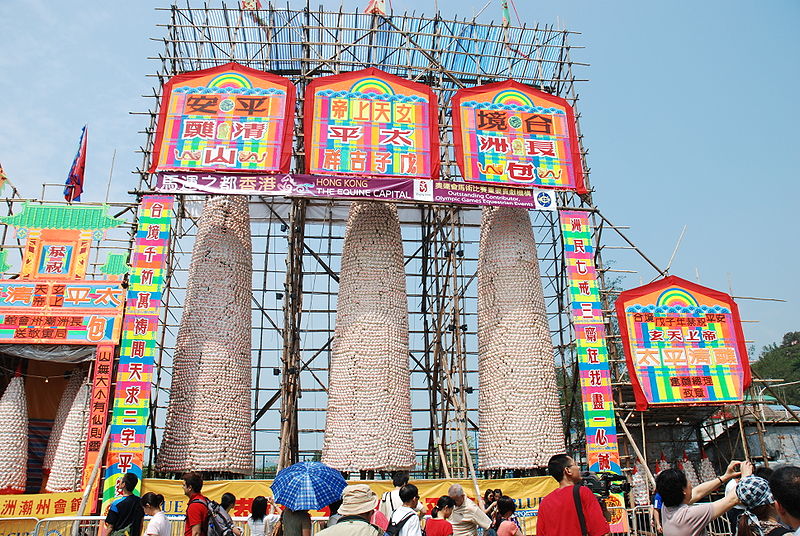Cheung Chau Bun Festival or Cheung Chau Da Jiu Festival is held annually and is considered a Taoist sacrificial ceremony. It is coinciding with the local celebration of Buddha’s birthday. This festival is celebrated to drive away evil spirits and to ensure smooth sailing of its sea-faring residents. The islanders organize a week-long Thanksgiving celebration.
Cheung Chau Bun Festival is celebrated during the eighth day of the fourth month in the Chinese lunar calendar. It usually falls in the early days of May. It is a traditional Chinese festival on the island of Cheung Chau in Hong Kong, and is by far the most famous Da Jiu festival and has the most public exposure. These events are mostly held in rural communities in Hong Kong. Places like Taiwan, Sichuan, Fujian, and Guangdong also share the folk custom.
The festival began as a fun and exciting ritual for fishing communities to pray for safety, and it became a medium to showcase the traditional Chinese culture. There are many stories of how this festival started. One of it was in the 18th century when the island of Cheung Chau was devastated by a plague. People prayed to Pak Tai, the god of water and spirit of the north to keep them safe from the plague. The second story was about the time when the island was infiltrated by pirates until the local fisherman brought an image of the god Pak Tai to the island. They paraded the image through the village lanes and they believed that the deity drove away from the evil spirits. The island’s Temple of the Jade Vacuity is dedicated to Pak Tai.
Cheung Chau Bun festival draws about ten thousand local and foreign tourists every year. The festival begins with three 60-foot towers covered with sweet buns or doughy pastries from top to bottom set in front of the Pak Tai temple. People will grab as many sweet buns as they can possibly get from the towers. They believe that the more pastries they get, the better luck they will have for the coming year.
The centerpiece of the festival is in Pak Tai temple where the bun mountains or bun towers stand. These are three giant 60-feet bamboo towers covered with buns. Historically, young men would race up the tower to get hold of the buns. The higher the bun, the better fortune it was supposed to bring to the holder’s family. The race was known as bun-snatching. However, in 1978, one of the towers collapsed and more than 100 people were injured, that’s why the bun-snatching ritual was abandoned by the government decree.
Many Cheung Chau villagers still regard the Cheung Chau Bun Festival as part and parcel of their life. It also exhibits the precious culture of Hong Kong. A local cartoon movie “My Life as McDull” recalled the abandoned ceremony in addition to the villagers’ immense urge to resume the ritual. It gave nostalgia to its viewers.
The long-awaited ritual was reintroduced on May 15, 2005, due to its great popularity. Only twelve well-trained athletes selected from preliminary competitions were permitted to climb on one single bun mountain. Safety measures were intensified and instead of bamboo, the framework of the bun mountain was made of steel.
In 2005, a single tower climbing event in the adjacent sports ground was revived as a race adding extra safety precautions. The race includes proper mountain-climbing tools as well as tutorials for participants which now includes women.
In 2006, a teamwork version of the event was added. In the midnight of the festival, the revised version of bun-snatching and the traditional three bun mountains buns are removed from the towers.
It was announced that the buns on the single-tower will be henceforth constructed made of plastic in February 2007. Chinese operas, lion dances, and religious services also take place on the island during the festival.
At a quarter to midnight, a paper effigy of the King of the ghosts is set ablaze where enormous incense sticks are lit. The buns from the bun mountains are harvested and distributed to the villagers who enjoy sharing in this propitious good fortune and loves to rejoice late into the night.
The festival lasts for seven days. In three days, the entire island goes vegetarian. Most of the island’s famous restaurants adhere to this tradition. The local McDonald’s also takes meat off the menu and sells veggie burgers made of mushroom instead.
In addition to the traditional lion dances and dragon dances, children are dressed as legendary and modern Chinese heroes. They are suspended above the crowd on the tips of swords and paper fans. They form the parade-in-the-air and are all secured within steel frames until they appear to glide through the air. Parents consider it a great honor for their kids to be part of the parade.
This fascinating procession is accompanied by the bedlam of musicians loudly beating gongs and drums to scare away evil spirits. It is led by a spectacular image of Pak Tai.
Cheung Chau Bun Festival is not just a simple festival for most of the Chinese community, because it plays a big part in their life and gives them a feeling of nostalgia. It is an important Thanksgiving celebration tribute to their god Pak Tai for giving them safety and good fortune.


